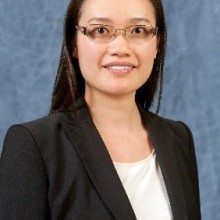Fabrication and Modeling of Wearable Energy Generation and Storage Units
Yarn-shaped supercapacitors (YSCs) or batteries are becoming promising energy-supply units with decent mechanical flexibility to be integrated into e-textiles in various shapes and locations. However, a robust YSC configuration that can provide long-term and reliable power output, especially after rigorous weaving and knitting processes, as well as all kinds of end uses, is yet to be established. Most YSCs today still suffer from short-circuiting upon length, primarily due to the structure failure of gel electrolyte that also works as the separator. Moreover, a prominent length-dependent output has been observed in YSCs, which signs the plateaued capacitance at extended lengths. In this talk, we will give an overview of existing issues of the state-of-the-art YSCs, and their possible solutions or mitigation strategies. In detail, we discuss the incorporation of separator threads in a twisted YSC, to withstand repetitive mechanical deformations. Separator threads are wrapped outside of yarn electrodes as a scaffold to accommodate gel electrolyte, while chemistry and wrapping density of these threads are investigated. With processing parameters optimized, we present an YSC configuration that can bear mechanical deformations along almost all directions, leading to reliable power units in woven or knit fabrics. A detailed mathematical model of YSCs will also be discussed to clarify the length dependence of their performance.
On the other hand, harvesting biomechanical energy from daily human-body motions provides a promising and sustainable power solution for wearable electronics, whose current power supplies, i.e. batteries, have unsatisfactory capacity and durability due to volume, shape, and flexibility constraints. Electromagnetic generators (EMGs) are favorable energy transducers because of their high energy- conversion efficiency, low dependence on frequencies, and long-term stability. However, an EMG that can effectively harvest energy from multi-directional arm motions at aperiodic low frequencies are yet to be created. Here we introduce a unique EMG configuration by combining a linear and a helix frame into a monolithic unit, enabling the EMG to scavenge energy from all kinds of arm motions up to 6 degrees of freedom (DOFs) (movement along XYZ axes and forearm rotations). The EMG frame geometry is designed and optimized according to numerical simulations. To clarify the working mechanism and maximize the power output, the copper coils’ winding pattern, the magnets’ velocity profiles, and the resulted voltage output are numerically simulated and then experimentally verified. Our EMG-LH outperforms linear EMGs and helix EMGs in harvesting energy from all arm motions. This work explicitly presents a forearm-wearable energy harvester as a sustainable power source for wearable electronics.

Dr. Wei Gao
Textile Engineering, Chemistry & Science Department, NC State on March 9, 2023 at 12:00 PM in MRC 454
Dr. Gao is an Associate Professor and University Faculty Scholar in the Textile Engineering, Chemistry & Science Department at NCSU. Her previous and recent research activities can be accessed on her google scholar webpage. Dr. Gao worked as a Director’s Postdoctoral Fellow in the Los Alamos National Laboratory before joining NCSU as a faculty member in 2015. She obtained her Ph.D. in chemistry from Rice University, under the guidance of Professor Pulickel M. Ajayan. Her Ph.D. thesis focused on a group of 2D materials named as “graphene oxides” and their applications in catalysis, energy storage, water purification, and fuel cells. Dr. Gao has several years of research experience on nanomaterials and nanotechnologies, with an h-index of 38, an i10-index of 57, and over 14,000 citations to her credit. 1 After joining the Wilson College of Textiles at NCSU, Dr. Gao has focused on applying these two-dimensional nanomaterials in textile systems for a variety of applications. Dr. Gao teaches textile dyeing and finishing, as well as fiber and polymer characterizations in the college. Her current research interests lie at the interfaces between nanotechnologies and textile engineering.
ASSIST is developing leading-edge systems for high-value applications such as healthcare and IoT by integrating fundamental advances in energy harvesting, low-power electronics, and sensors with a focus on usability and actionable data.
